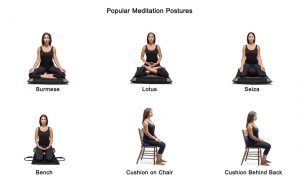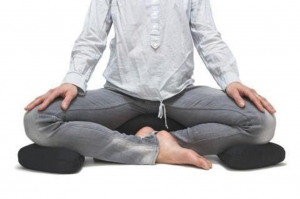One of the most common questions I get revolves around meditation posture. In turn, this guide is my attempt to share the essential info on how to go about the sitting posture. It’s sort of like several articles in one — use the index as a guide and feel free to bounce around!
Table of Contents
What Is the Best Meditation Posture?
There is no such thing as the “best posture.” Traditionally, we’re instructed to practice meditation while sitting, standing, walking and lying down — basically, any position we can put ourselves in.
However, the stereotypical image of a meditator is of course doing “sitting meditation.” This is because it tends to offer the best balance of relaxation and alertness. For example, there are fewer distractions than when walking, less likelihood of falling asleep than when lying down, and a little more relaxing than standing.
In turn, for sitting meditation, we simply want to choose a posture that helps us feel relaxed and alert. Trust yourself. Whatever seems like it works is probably best!
There are a few styles of cross-legged meditation (shown in the photo below), and it’s also perfectly okay to sit in a chair. Different postures work best for different people, so it can be good to experiment.
All Postures are Uncomfortable!!
Some people have chronic pain or discomfort, and the experience of being in their body is not particularly pleasant. Other people can get comfortable in a meditation posture for a few minutes, or maybe even an hour or two, but in either case, that position too eventually becomes uncomfortable.
Even the most flexible and in-shape person in the world will experience discomfort after walking for 7 hours continuously, or lying down for 14 hours without moving.
What I’m trying to say is that meditation is not about avoiding discomfort, but rather learning to be with both comfort and discomfort with equanimity, perspective, and patience. However, it’s certainly a good idea to be kind to ourselves and choose optimal postures.
So set yourself up for success.
If cross-legged meditation isn’t comfortable for more than a few minutes, then sit in a chair — really! If that doesn’t work, give more time to walking meditation or lying down meditation.
You could also take a longer-term approach and do what I did — develop a regular Yoga practice. Over the course of years, your body will become noticeably more open, flexible and comfortable.
When I started meditating I couldn’t still without discomfort for more than five minutes. During my first meditation retreat, the teacher literally called me in for a private interview to ask if I was doing alright because he noticed how much I was fidgeting, moving, and adjusting my body. It was rough!
Fast-forward many years and I can now sit cross-legged for about 60-90 minutes pretty comfortably. When it inevitably starts to get uncomfortable (some days when I’m drowsy it happens very quickly!), I don’t move right away and use the discomfort as practice.
And, while I sit cross-legged on a cushion about 75% of the time, I also sometimes use a bench, do standing meditation (especially when I’m sleepy), occasionally do chair or lying down meditation, and turn most of my walks into “informal meditation.” In other words, it can be helpful to switch it up!
This is to say that physical discomfort in meditation is something most people experience, but armed with info like this, we can make the most of it.
See this article on the difference between formal & informal meditation.

A Few Key Tips for Sitting Meditation
Here are some helpful tips for any of the postures shown above.
- Maintain an upright/straight spine with about 5-10% slack, like a guitar string that’s neither too loose nor too tight. One tactic to experience this is to imagine there is a string that runs from your pelvic floor, through your midsection and up to the crown of your head. Take a big inhale and imagine you are lifting that string up to the ceiling as much as you can. Your spine will be 100% upright. Notice this is rigid and tight. Then on the exhale relax the string, and find a resting place where your spine is upright, but there’s about 5 to 10% relaxation/slack in the string.
. - Keep your knees either at the same level as your hips or lower. This helps keep the natural curve of the spine and will help prevent back pain. Often times, this means sitting up higher.
. - No “floating” knees! If you’re cross-legged on the floor and your knees don’t touch the ground, put a cushion or blanket under them so they aren’t floating a few inches above the ground. This will help prevent knee-pain, and will also help keep your feet/legs from falling asleep. This is shown in the photo below.
. - Relax your muscles! It’s very possible to keep an upright spine even with a relaxed pelvis, abdomen, jaw, shoulders, and forehead. One powerful practice is simply noticing our unconscious tendency to tense our muscles (which also tenses our mind!).
. - For sitting cross-legged, “Burmese style,” also shown in the below picture, is the most popular. Unless you have an extreme amount of hip flexibility, I do not recommend half or full lotus, as it tends to put subtle levels of stress on your knees that will reveal themselves in the long-run.
. - In the below photo, note that his feet are going to start to hurt a lot, as he has no cushioning under them. Always put a rug, blanket, “zabuton,” etc. under your feet.

Is it Okay to Adjust my Posture During Sitting Meditation?
Yes! It can’t be stressed enough that there is nothing special about staying perfectly still (or even the sitting posture itself) — it’s all just an aid to help us be more aware.
However, we are training our ability to be responsive instead of reactive.
In turn, if any mild discomfort starts to come up, the idea of insight meditation is to notice your worries and other reactions, and see if you can allow them to be there without grasping onto them or trying to push them away! See if you can find patience, ease and choicefulness even amidst discomfort.
Often times, shifting our attitude a little bit and giving discomfort permission to be present leads to it fading away.
Although, if it doesn’t fade away, and the discomfort becomes stronger or just too painful, then it’s actually really wise to shift your posture. Just consciously notice that you’re doing it!

What to Do if my Legs or Feet Go Numb?
Similar to what I said in the previous section, the first step is simply to notice it and give it permission to be present! Physical numbness can also be a beautiful opportunity to develop wisdom: to notice our reactions, emotional responses, the sense of it being “bad” or the idea that “my meditation will be better if it goes away.” Simply to notice all that and allow the numbness as well as the mind space to just be.
However, people do get particularly nervous about their legs or feet going numb, and fear it might be causing harm. I’m not a doctor so don’t take this as sound medical advice (and defer to your doctor’s judgment if you’re really concerned), but my opinion is that unless you’re maintaining numb legs for a few hours at a time, you’re not going to hurt yourself.
I’ve done many meditations with over an hour of numb legs and the feeling always returns. In many years of teaching, going on retreats, and talking with hundreds if not thousands of other meditators, I’ve never heard one story of someone doing irreparable harm because their legs went numb during meditation.
In other words, if it’s at a distraction level that’s gentle enough you can still have a patient, curious, accepting and/or equanimous attitude, don’t worry about it!
However, if it becomes too distracting, there are two good options:
- Adjust your posture! See the previous paragraph — no brownie points for sitting like a statue, but if you do move your posture, see if you can do it intentionally and consciously instead of just reactively swinging your leg out 😉
- Use this gentle “method” to return the feeling to your legs. Basically, leg/foot numbness happens because your sciatic nerve, which runs from your lumbar spine through your leg, gets pinched around your hips. The remedy, random as it may sound, is to lean forward for about 30-40 seconds, put your hands on the ground in front of you, and put your weight into your hands. Feeling will return!

What Meditation Sitting Supplies to Use?
In terms of formal sitting meditation, there are three basic options: a floor cushion, a bench, and a chair. While you can just use a random pillow, getting the optimal supplies can make a big difference for comfort and sustainability. I generally use a meditation cushion at home, and on intensive retreats, alternate between a cushion, a bench, and occasionally a chair.
When I’ve had soft carpet floors, I put my cushion directly on top of the carpet, but when I’ve had hard floors, I put use a floor mat / zabuton underneath the cushion.
Below is a guide to benches, cushions, chairs, and zabutons — feel free to just skip the analysis and find the bolded recommendations.
Benches
This is my preferred bench, largely because it’s comfortable and portable. It’s a bit pricey, but you can also usually find it cheaper on eBay.
I also have one of these, which is a comfortable cheaper option if you don’t care about portability.
If you look elsewhere, here are the four main considerations for choosing a bench.
- Cushioning. Get something upholstered or plan on putting a cushion/blanket on top of it.
- Height. Benches come in different heights — at 6’0″, I prefer the taller one in the first link.
- Portability. The one I linked has foldable legs, which makes it portable, but this costs more and is useless for many people.
- Angling. They come flat-topped or angled. Most people find the angling supportive of better ergonomics, but everyone is different.
Meditation Cushions
There are countless brands and styles of meditation cushion. It can be hard to figure out what to choose. In turn, if you have a meditation store near you, or a meditation/spiritual center with lots of cushions, it’s helpful to just go try some out and get a feel for what you like.
More broadly, you could roughly break down the important criteria into a few basic qualities: height/width, shape, comfort, and filling material.
For the height/width, I like to have a width of at least 14″, so my whole bottom can fit on the cushion, which means less legs falling asleep. For the height, you mostly don’t want too short or too tall. It varies by the person, but 4 to 6″ is usually good for most people.
For the shape, if it meets the above height/width criteria, the rest is mostly just marketing. The exception would be for folks with tighter hips, it can be nice to have one with a downward angle or possibly a crescent shape.
For the comfort, you ultimately want something that feels nice to sit on. It varies by the person, but generally speaking, I find kapok, millet, air, and latex to be preferable, as cotton and foam compress over time, while buckwheat is a little harder. That being said, some folks love cotton, foam and buckwheat cushions!
The most important consideration is filling material. You can find a cushion made out of, say, cotton, for $40 from one company and another cotton cushion for $100 from the next. The $60 difference is mostly just marketing.
In turn, it’s helpful to have a sense of the different filling materials:
My Recommended Cushions, organized by filling material
In brief, if you are a casual meditator going for affordable, pick the cotton one. If you are planning to meditate a bit more, go with the millet or kapok.
Millet cushions. A grain that is softer, more comfortable and quieter than buckwheat (but also more expensive). Doesn’t compress over time. The one I used for years is only available in person at the Portland Saturday Market. Alternatively, this one looks good, though it is expensive (note: they have multiple colors and sometimes runs significant sales).
Cotton Cushions. Affordable. Are generally comfortable, though with prolonged use, they compress over time, making them less comfortable. A standard cushion you’ll find at lots of meditation centers. Here is one I own that I like.
Kapok Cushions. These are comfortable like cotton but are way more compression-resistant, so they are much more sustainable and long-lasting. Personally, I don’t like them overstuffed, so with the store-bought ones, I would usually remove some filling to make them softer. I have stuffed my own, but it’s a considerable pain in the rear, so just do yourself a favor and buy one instead! Here is one place that has both the crescent and round shape. Here is a cheaper option if you shop on Amazon.
Air cushion. Extremely portable and surprisingly comfortable. This is what I’ve mostly been as my main cushion using in recent times. However, it doesn’t give the same amount of back support as a harder cushion, so not everyone loves them. I use this one, though several close meditation friends like this ZenAir cushion.
Buckwheat cushions. Affordable. Offer a firm, stable seat. Will not compress over time. Can be a bit noisy if you’re moving around. If you are doing lots of sitting, the hardness can be uncomfortable, but for casual home use, they are usually great. Here are some good options.
Latex Cushions. I’ve never seen these sold, but they are one of my favorites. Very comfortable with a nice balance of firmness and give, but also won’t compress. I’ve stuffed my own, which only cost about $40-$50 after buying a 5lb bag of “shredded latex” on eBay, and then an empty meditation cover on Etsy (or your retailer of choice). Very easy to stuff.
Foam / Polyurethane. For about a year or two in my early days, I used a foam yoga bolster as my meditation cushion. This can work too, but it does compress over time, and loses some of its support.
Floor Mat / Zabuton
If you aren’t meditating on carpet (or blanket, etc.), having cushion underneath you is essential to avoid discomfort. In basically all monasteries and meditation centers, they use “zabutons,” a roughly 3′ x 2′ cushioned floor mat that you sit on top of with your cushion.
You can basically choose whatever material you like, but I’d recommend Kapok for the reasons I listed above. Here is an affordable Kapok zabuton (note: add the $6 yoga towel to qualify for free shipping, which would otherwise cost more than $6). Here’s an Amazon option to match the Kapok cushion I shared above.
If you get one elsewhere, just make sure it’s wide enough to fit your whole body on — usually about 3′.
Chairs
If you’re in a chair, it’s best to choose something that allows you to sit with an upright spine, as opposed to, say, a couch that you sink into. It’s mildly preferable to not lean against the back of the seat (more alertness), but if you can do so while maintaining an upright spine, it’s not a big deal as it is more relaxing.
I recommend having a blanket, cushioning, or upholstery underneath your bottom.
Similiar to what I shared above, you want your knees at or slightly below the height of your waist. If this isn’t the case, either add more height to your seat. Likewise, if your feet can’t firmly sit on the ground, put down some blankets so they can.
Given the above criteria, really any chair that fits the above will do.
Another article you might enjoy is should the eyes be open or closed during meditation?

Thanks David 🙂 very helpful
Thanks, very helpful guidance. Just what I needed.
I would also like to add that I have been instructed by several traditional yoga some by books ,some by Swamis, that it is best to sit facing east or north. Or another words facing the Himalayan mountains or where the Sun rises.
Thank you for sharing such a clear and practical guide on meditation posture. Your tips—like keeping the spine upright yet relaxed, grounding the knees, and being gentle with discomfort—are essential for a sustainable practice. I also appreciate your inclusive approach, reminding readers that any posture supporting alertness and ease is valid.